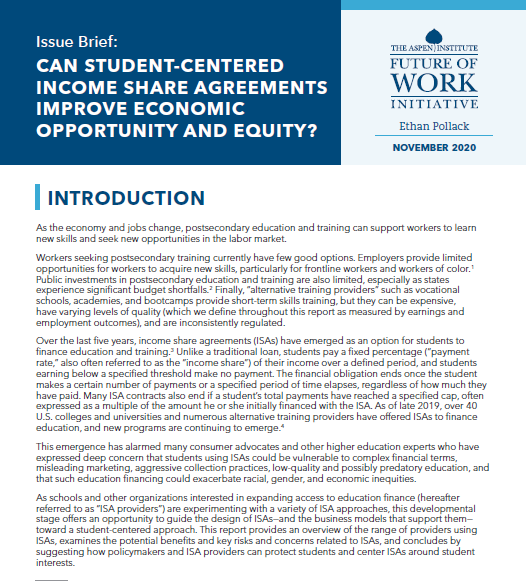Introduction
As the economy and jobs change, postsecondary education and training can support workers to learn new skills and seek new opportunities in the labor market.
Workers seeking postsecondary training currently have few good options. Employers provide limited opportunities for workers to acquire new skills, particularly for frontline workers and workers of color. Public investments in postsecondary education and training are also limited, especially as states experience significant budget shortfalls. Finally, “alternative training providers” such as vocational schools, academies, and bootcamps provide short-term skills training, but they can be expensive, have varying levels of quality (which we define throughout this report as measured by earnings and employment outcomes), and are inconsistently regulated.
Over the last five years, income share agreements (ISAs) have emerged as an option for students to finance education and training. Unlike a traditional loan, students pay a fixed percentage (“payment rate,” also often referred to as the “income share”) of their income over a defined period, and students earning below a specified threshold make no payment. The financial obligation ends once the student makes a certain number of payments or a specified period of time elapses, regardless of how much they have paid. Many ISA contracts also end if a student’s total payments have reached a specified cap, often expressed as a multiple of the amount he or she initially financed with the ISA. As of late 2019, over 40 U.S. colleges and universities and numerous alternative training providers have offered ISAs to finance education, and new programs are continuing to emerge.
This emergence has alarmed many consumer advocates and other higher education experts who have expressed deep concern that students using ISAs could be vulnerable to complex financial terms, misleading marketing, aggressive collection practices, low-quality and possibly predatory education, and that such education financing could exacerbate racial, gender, and economic inequities.
As schools and other organizations interested in expanding access to education finance (thereafter referred to as “ISA providers”) are experimenting with a variety of ISA approaches, this developmental stage offers an opportunity to guide the design of ISAs—and the business models that support them—toward a student-centered approach. This report provides an overview of the range of providers using ISAs, examines the potential benefits and key risks and concerns related to ISAs, and concludes by suggesting how policymakers and ISA providers can protect students and center ISAs around student interests.
Research Approach
This report is the culmination of a year-long research project conducted by the Aspen Institute Future of Work Initiative to explore how ISAs could be designed and operated to improve economic opportunity for American workers. Seeking opportunities for stakeholders with diverse viewpoints about ISAs to deliberate and seek consensus, the Initiative conducted nearly 40 formal interviews with stakeholders across the ISA landscape, including non-profit, for-profit, and workforce ISA providers; impact investors; philanthropic organizations; consumer protection advocates; workforce experts; and higher education policy experts. The Initiative then organized a small group of practitioners and policy professionals to discuss policy guardrails and student-centered ISA principles over the course of two roundtable discussions. Finally, the Initiative invited experts whose work has focused on the risks that ISAs pose to students, their impact on racial and gender equity, and ISAs’ role in the broader higher education financing system to join a larger convening in the fall of 2020. Throughout this process, the Aspen Institute Economic Opportunities Program played an advisory role in this project, drawing on its extensive work related to strategies to help low-income adult learners earn credentials and connect to good jobs.
Summary of Policy Guidance & Principles for Student-Centered ISAs
Guidance to Policymakers
Strong policy guardrails around the design and operation of ISAs can help ensure that students are better protected, and that ISAs align with their interests.
- Ensure existing federal and state consumer credit protections are appropriately applied to ISAs
- Consider new protections uniquely designed for ISAs
Principles for Providers
Principles can help ISA providers, as well as investors and philanthropic organizations that work with providers, understand how to design and operate ISAs to protect and center students’ interests.
- ISA providers should ensure students understand what they are signing up for
- ISA providers should design ISAs so that all students can make payments and afford basic living costs
- ISA providers and their investors should bear most of the risk of poor economic outcomes
- ISA schools should provide information on education and employment programs outcomes to the public
- ISA providers should work to reduce existing racial and gender disparities
- ISA providers should carefully choose their investors and design their financial arrangements to avoid undermining the alignment between the provider’s financial incentives and students’ performance
- ISA providers should encourage students to explore all available federal financial aid options prior to entering into ISA contracts
- ISA providers should collect and consider student and former student input when designing and improving ISA terms
- ISA providers should strive to be consistent with existing federal and state laws governing traditional loans
The Future of Work Initiative is grateful to Lumina Foundation and Walmart.org for providing funding for this publication. The statements, views, and conclusions expressed in this publication are solely the responsibility of the author.


